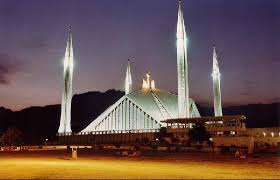|
Combining a rich history, the confluence of many a civilization and temperate
climate, Islamabad - the capital city of Pakistan, is one of the most beautiful
cities in the South Asian region. Wide, tree-lined streets adorn the various
sectors and zones of the city, making it accessible and spectacular.
Administratively, the city is located within the Islamabad Capital Territory,
which is federally controlled, even though historically Islamabad has been a
part of the Punjab province; more specifically the Potohar Plateau. A
meticulously planned city by renowned town planners Doxiadis Associates,
Islamabad is the fastest growing city in terms of population, economy and urban
development. As this trend continues, the city is shedding its reputation as a
city without character, and is fast becoming truly
metropolitan. |
|
History of
Islamabad
|
 |
 After the
formation of Pakistan in 1947, it was felt that a new and permanent Capital City
had to be built to reflect the diversity of the Pakistani nation. It was
considered pertinent to locate the new capital where it could be isolated from
the business and commercial activity of the Karachi, and yet be easily
accessible from the remotest corner of the country. After the
formation of Pakistan in 1947, it was felt that a new and permanent Capital City
had to be built to reflect the diversity of the Pakistani nation. It was
considered pertinent to locate the new capital where it could be isolated from
the business and commercial activity of the Karachi, and yet be easily
accessible from the remotest corner of the country.
A commission was accordingly set in motion in 1958, entrusted with the task
of selecting a suitable site for the new capital with a particular emphasis on
location, climate, logistics and defense requirements, aesthetics, and scenic
and natural beauty.
After extensive research, feasibility studies and a thorough review of
various sites, the commission recommended the area North East of the historic
garrison city of Rawalpindi. After the final decision of the National Cabinet,
it was put into practice. A Greek firm, Doxiadis Associates devised a master
plan based on a grid system, with its north facing the Margallah Hills. The
long-term plan was that Islamabad would eventually encompass Rawalpindi
entirely, stretching to the West of the historic Grand Trunk road.
Islamabad nestles against the backdrop of the Margallah Hills at the northern
end of Potohar Plateau. Its climate is healthy, pollution free, plentiful in
water resources and lush green. It is a modern and carefully planned city with
wide roads and avenues, elegant public buildings and well-organized bazaars,
markets, and shopping centers.
The city is divided into eight basic zones: Administrative, diplomatic
enclave, residential areas, educational sectors, industrial sectors, commercial
areas, and rural and green areas.
The metropolis of Islamabad today is the pulsating beat of Pakistan,
resonating with the energy and strength of a growing, developing nation. It is a
city which symbolizes the hopes and dreams of a young and dynamic nation and
espouses the values and codes of the generation that has brought it thus far. It
is a city that welcomes and promotes modern ides, but at the same time
recognizes and cherishes its traditional values and rich history. |
|
|
 About Islama
About Islama After the
formation of Pakistan in 1947, it was felt that a new and permanent Capital City
had to be built to reflect the diversity of the Pakistani nation. It was
considered pertinent to locate the new capital where it could be isolated from
the business and commercial activity of the Karachi, and yet be easily
accessible from the remotest corner of the country.
After the
formation of Pakistan in 1947, it was felt that a new and permanent Capital City
had to be built to reflect the diversity of the Pakistani nation. It was
considered pertinent to locate the new capital where it could be isolated from
the business and commercial activity of the Karachi, and yet be easily
accessible from the remotest corner of the country.
No comments:
Post a Comment